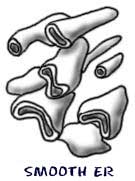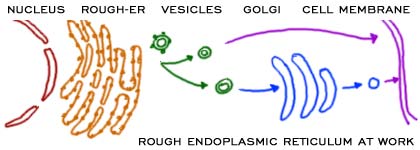Structurally, the endoplasmic reticulum is a network of membranes found throughout the cell and connected to the nucleus. The membranes are slightly different from cell to cell and a cell’s function determines the size and structure of the ER. For example, some cells, such as prokaryotes or red blood cells, do not have an ER of any kind. Cells that synthesize and release a lot of proteins would need a large amount of ER. You might look at a cell from the pancreas or liver for good examples of cells with large ER structures.
Rough and Smooth
There are two basic types of ER. Both rough ER and smooth ER have the same types of membranes but they have different shapes. Rough ER looks like sheets or disks of bumpy membranes while smooth ER looks more like tubes. Rough ER is called rough because it has ribosomes attached to its surface. The double membranes of smooth and rough ER form sacs called cisternae. Protein molecules are synthesized and collected in the cisternal space/lumen. When enough proteins have been synthesized, they collect and are pinched off invesicles. The vesicles often move to the Golgi apparatus for additional protein packaging and distribution.
The double membranes of smooth and rough ER form sacs called cisternae. Protein molecules are synthesized and collected in the cisternal space/lumen. When enough proteins have been synthesized, they collect and are pinched off invesicles. The vesicles often move to the Golgi apparatus for additional protein packaging and distribution. Smooth ER (SER) acts as a storage organelle. It is important in the creation and storage of lipids and steroids. Steroids are a type of ringed organic molecule used for many purposes in an organism. They are not always about building the muscle mass of a weight lifter. Cells in your body that release oils also have more SER than most cells.
The sarcoplasmic reticulum (SR) is a variation of the SER. It is able to store many ions in solution that the cell will need at a later time. When a cell needs to do something immediately, it doesn’t make sense to search the environment for extra ions that may or may not be floating around. It is easier to have them stored in a pack for easy use. For example, when you are running around and your muscle cells are active, they need calcium (Ca) ions. The SR can release those ions immediately. When you are resting, they are able to store them for later use.

Rough ER (RER) was also mentioned in the section on ribosomes and is very important in the synthesis and packaging of proteins. Ribosomes are attached to the membrane of the ER, making it “rough.” The RER is also attached to the nuclear envelope that surrounds the nucleus. This direct connection between the perinuclear space and the lumen of the ER allows for the movement of molecules through both membranes.
The process of protein synthesis starts when mRNA moves from the nucleus to a ribosome on the surface of the RER. As the ribosome builds the amino acid chain, the chain is pushed into the cisternal space of the RER. When the proteins are complete, they collect and the RER pinches off a vesicle. That vesicle, a small membrane bubble, can move to the cell membraneor the Golgi apparatus. Some of the proteins will be used in the cell and some will be sent out into intercellular space.







0 comments:
Post a Comment